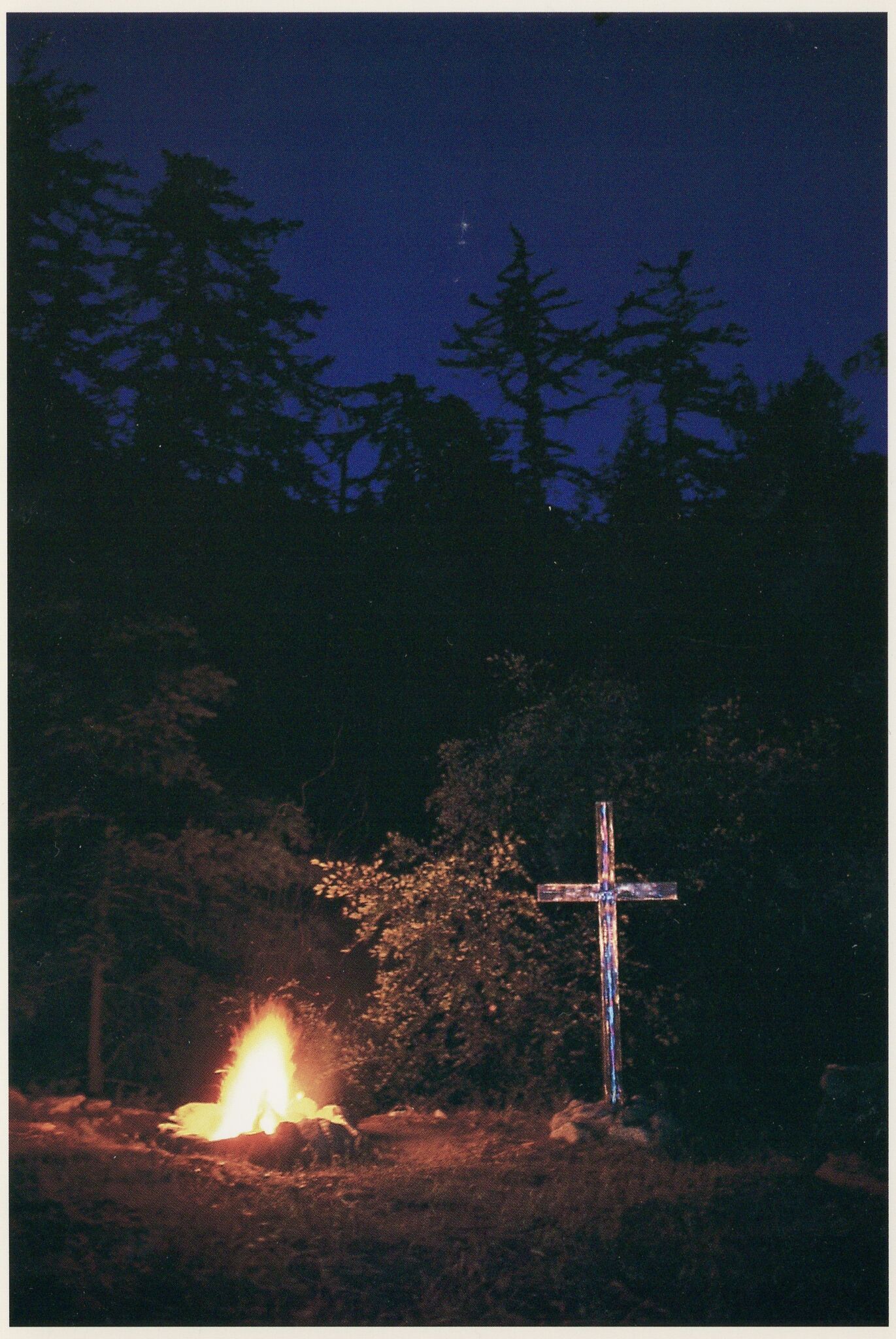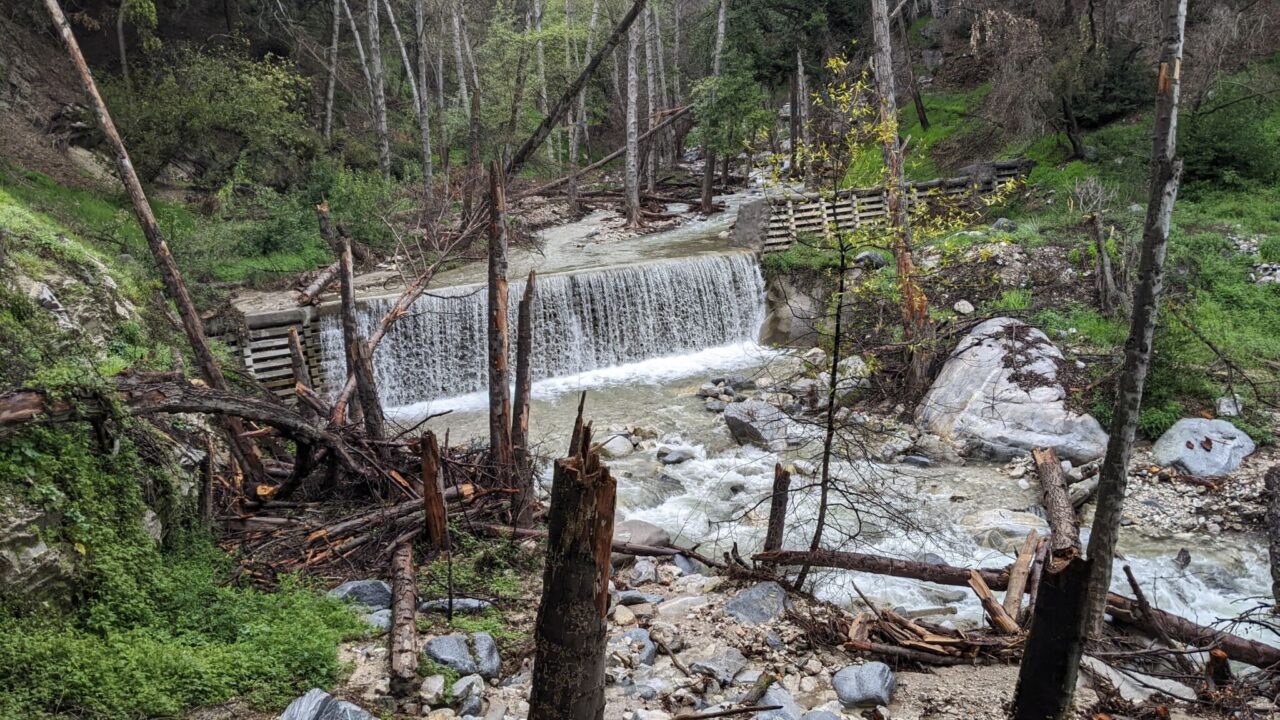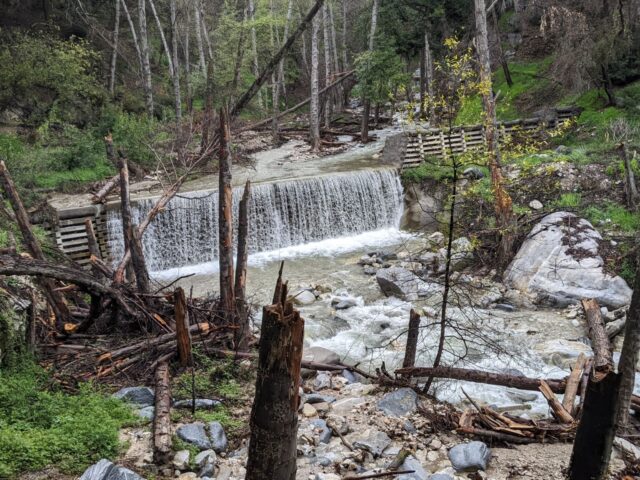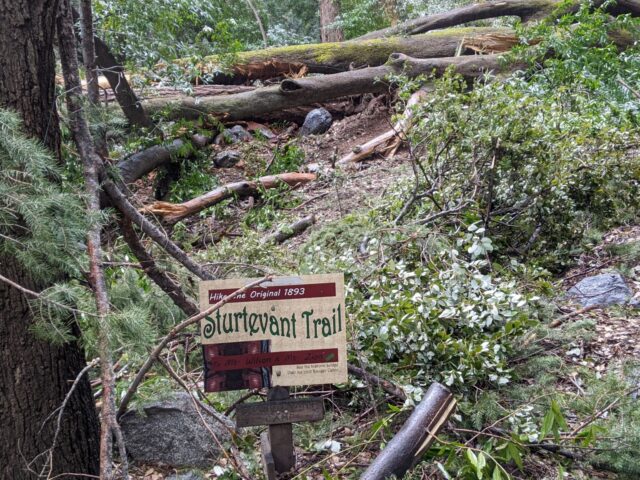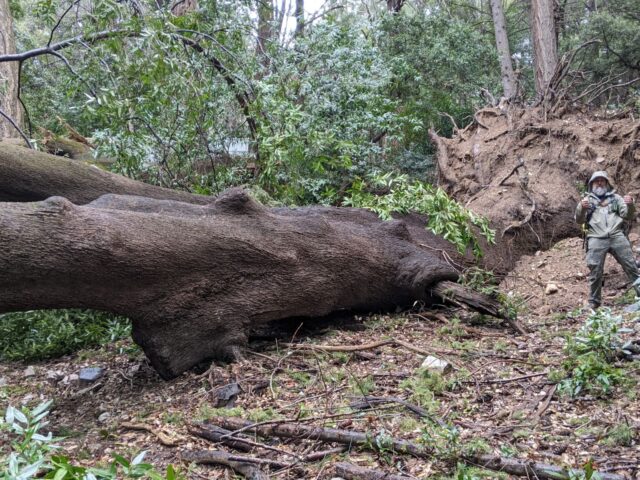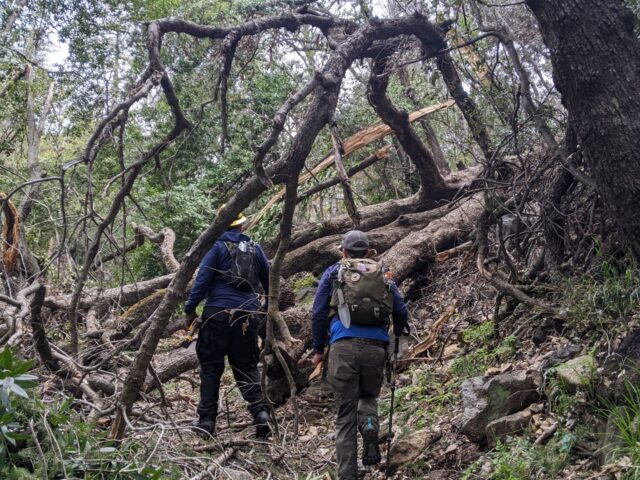These Boots Are Made for Sloshing
The Camp’s news is everyone’s news: wild weather across California and many other places, wreaking havoc in all kinds of ways, from inconvenient to fatal. Hikers have been eyeing the San Gabriels, watching snow pile up high and come down to lower elevations – including Camp. The nearly unrelenting rain has topped off not just the Camp’s 20” rain gauge* but the mountain soil itself; every little side canyon is a steady waterfall, and the stream is running so high there is no way into Camp without filling up your boots like bathtubs.
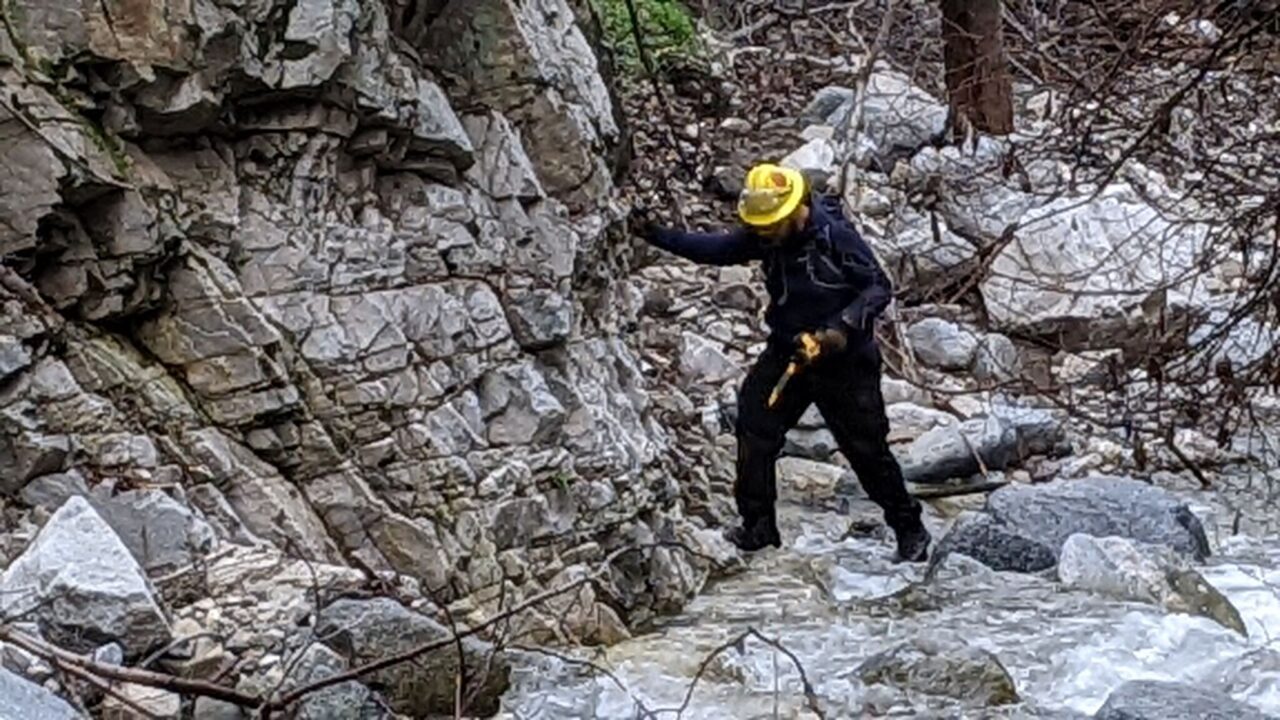
But water is more than a discomfort to volunteer’s toes: the saturated dirt is letting healthy and often large, mature trees topple over. With the canyon’s steep sidewalls, this means more timber is down across the trail than ever before, making the hike into Camp a jungle crawl. Working to stabilize the tread will now take a backseat to very heavy duty ‘brushing’.
In Camp, everything is under a thick green carpet of branches and blow-down; the trees are already loaded with fat seeds/cones from a wet autumn, making them susceptible to snow, rain, and wind cracking them off. Fortunately, all Camp structures are currently (knock on wood!) intact, with only a few crunched eaves from falling limbs.
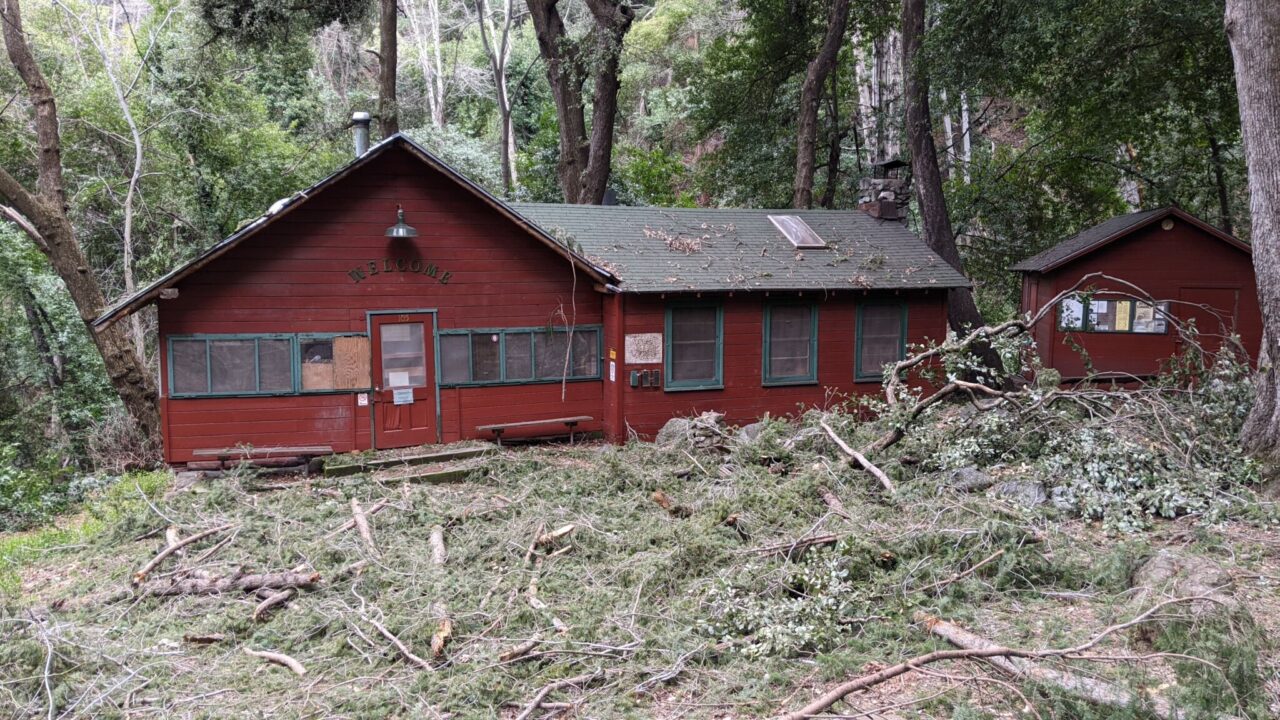
All this means progress on in-Camp projects is slowed down as we deal with the persistent challenge of trail access. Thanks to an equally tough and persistent network of volunteers, we’ll stay on the job and now that it’s officially spring, look forward what is sure to be an incredible season of wildflowers. Check back here for updates and photos! And as always, sign up to volunteer at sturtevantcamp.com/volunteer, and donate here sturtevantcamp.com/support.
*The average ANNUAL rainfall at Mt. Wilson is 33.35 inches; from December 11, 2022 to March 19, 2023, we’ve measured 38.75 inches at Camp!
More Than a Trail-Building Workshop
In early February, the U.S. Forest Service sponsored the Mt. Wilson Bicycling Association in offering a 2-day workshop on trail building. Board members Brent Pepper and Gary Keene, plus volunteer Nathan Bousfeld attended, alongside Maggie Moran from Adams Pack Station. Participants included other non-profit and advocacy groups, plus fire and forest service personnel. It was great to be in a room packed with people who love being in the outdoors, and working so others can share that experience.
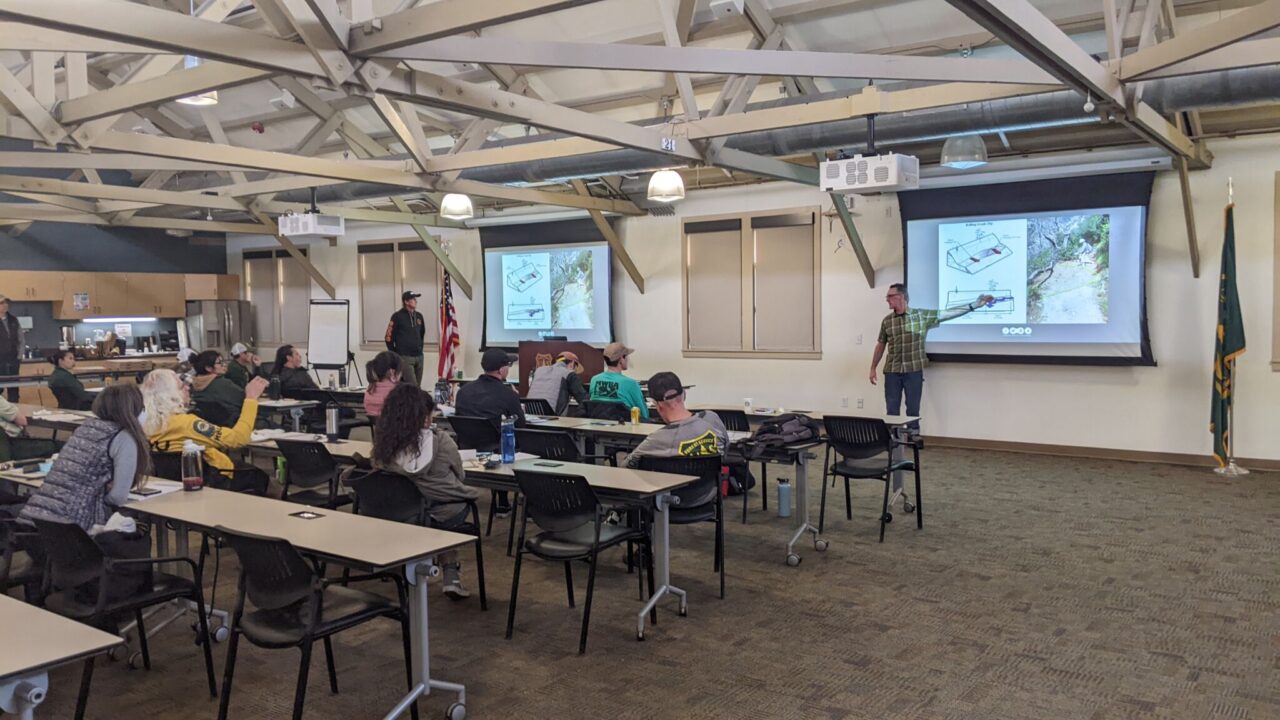
Although it was a chance to freshen up on underlying principles, current tools and techniques, compare notes and stories, it was most importantly a chance to connect face to face with key USFS personnel, including the new Angeles National Forest Supervisor, Roman Torres. There was also a lot of good coffee, pastries and pizza!
The workshop also included new post-pandemic statistics on changes in who is spending time in the outdoors: “The pandemic has attracted more diverse outdoor participants, and there is an opportunity to increase the diversity of the outdoor participant base long term. Compared to those who participated in outdoor activities in 2019, new participants are: more likely to be female (58% vs. 49%), younger (average age 45 vs. 54), ethnically diverse 66% white vs. 71%), live in urban areas (36% vs. 29%), and in a slightly lower income bracket (41% with income of $100K+ vs. 46%).”
This kind of data is useful to the Sturtevant Conservancy, because one of the provisions of our special use permit from the Forest Service is to serve children and youth and under-served populations.
The presentation also noted “Community health benefits: for every dollar invested in building trails, nearly three dollars in medical savings cost may be achieved. Being in nature can reduce stress, calm anxiety, lead to a lower risk of depression.” In contrast, no mention was made of bears, snakes or mountain lions, which have been known to increase hikers’ anxieties.
Forgotten History: the Becky Page Story
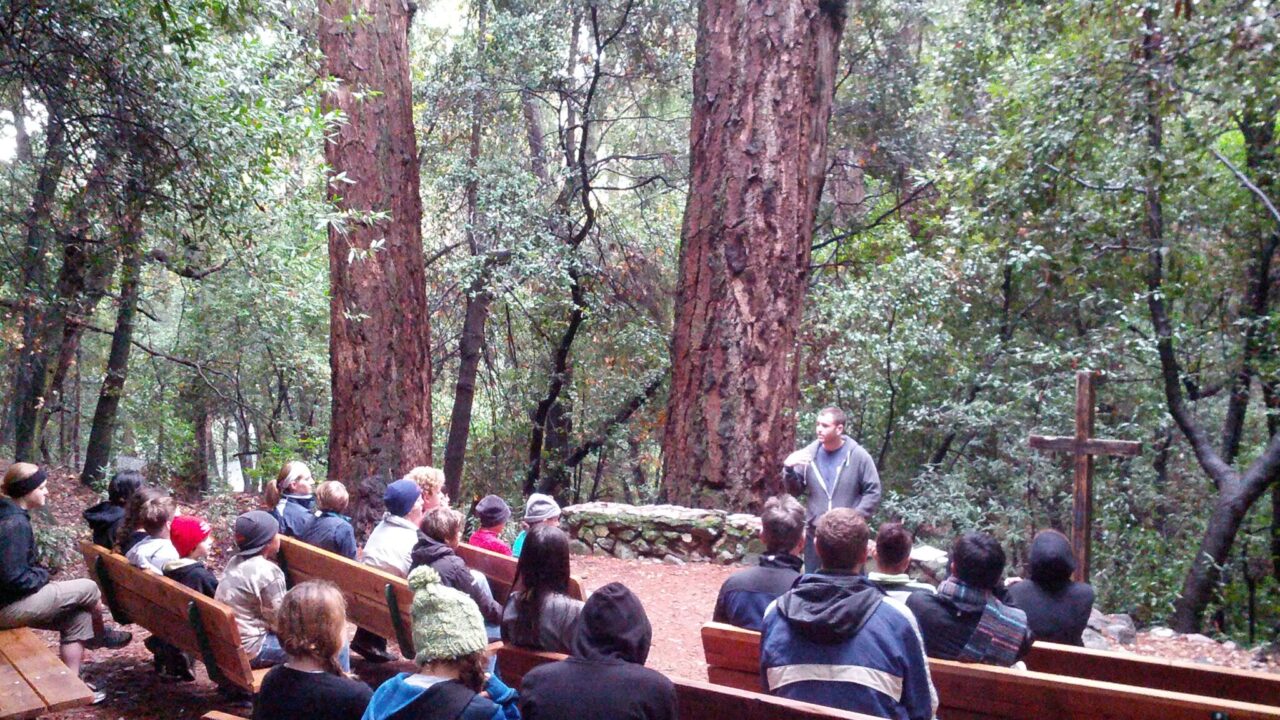
Not everyone knows Sturtevant Camp has an outdoor chapel tucked away upstream of the bunkhouse cabins. Sturdy benches sit on a false flat created by the shoulder of a check dam, looking across the stream and up into the forest canopy toward Mount Wilson – with a seven-foot-tall stainless steel cross right in the middle of the view!
Although Wilbur Sturtevant was a preacher’s kid, and the Camp was owned by the Methodist Church for more than half its existence, the Camp has always been open to the public and people of all faiths or none (in fact, the permit from the U.S. Forest Service requires it.) If there is any religion, it has been a belief in the glory of nature and creation.
So how did a Christian cross get there—and such a big, permanent one? Here’s the story, as told by retired Camp manager “Boots” Barto in a 1993 letter to then-manager Chris Kasten.
*Parental advisory: read first before sharing with smaller kids.
“It’s a beautiful spot on a hillside overlooking a sparkling creek, shaded by a huge Bigcone Spruce tree. The sounds of chattering squirrels and the playful squabbling of the blue jays with a background of rushing water was God’s way of preparing a perfect place for the Becky Page memorial cross.
I had been manager of Camp Sturtevant just a short time (in the spring of 1966 or ’67) when I was told that someone wanted to erect a stainless steel cross as a memorial to someone or other. Now I’ll tell you that I was not too excited to have a stainless steel cross erected at the most rustic Camp I’ve ever been to. I was sure a big chunk of stainless steel would be completely out of place so I ignored the suggestion.
Then I was invited to visit the artist, and I’m sorry I don’t remember his name, but he did live in Arcadia not far from where we lived. The meeting was an exciting education. He not only showed me some of his stainless steel art, he demonstrated how differently heat from a gas torch would change the color to blues, reds and browns, then how different they looked when the sun shone on them. I came away from that studio feeling happy and proud that Camp Sturtevant was chosen for the site of that beautiful cross. When I first saw the completed cross, it was on the back of a burro headed up the trail to Camp, a very impressive site.
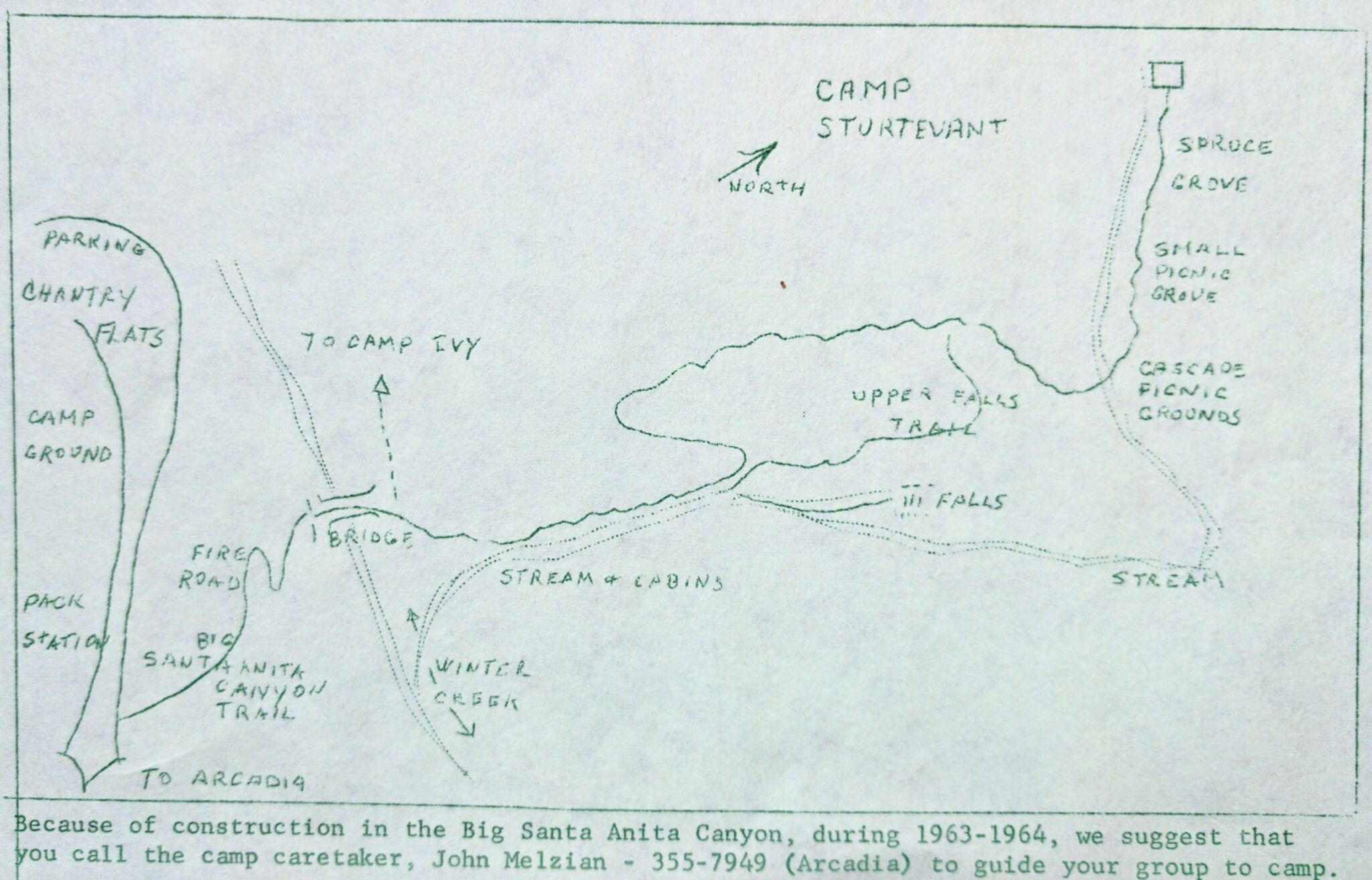 One rainy Saturday, a group of families headed by Win Ballance from the Church of the Good Shepherd in Arcadia hiked the four and half miles to Camp to install and dedicate the unusual memorial. A bucket brigade was formed to bring sand out of the creek while another group dug a fairly deep hole. Concrete was mixed to fill the hole around a heavy piece of channel iron to anchor the cross, hopefully for many years to come. Just as the last cement was poured and the cross leveled to perfection, Reverend Fred Coots hiked into camp and dedicated the Becky Page Cross with a short but meaningful service.
One rainy Saturday, a group of families headed by Win Ballance from the Church of the Good Shepherd in Arcadia hiked the four and half miles to Camp to install and dedicate the unusual memorial. A bucket brigade was formed to bring sand out of the creek while another group dug a fairly deep hole. Concrete was mixed to fill the hole around a heavy piece of channel iron to anchor the cross, hopefully for many years to come. Just as the last cement was poured and the cross leveled to perfection, Reverend Fred Coots hiked into camp and dedicated the Becky Page Cross with a short but meaningful service.
Now by this time I had a lot of interest in Becky Page. (Her) story came to me from a number of sources by bits and pieces, as follows:
Becky was a very cute little Junior high girl with leadership written all over her. Her family was an occasional church-going family, and this cute little girl had only been active in the junior high Methodist youth fellowship at the Arcadia church for a short time when the group spent a weekend at Camp Sturtevant.
On her return home, Becky bounced into the living room, dropping her back on the floor in true Junior high fashion, and exclaimed old mother I just had the most wonderful experience of my life. These were the last words that Becky was Heard to say. As her mother was talking on the telephone, Becky hurried out to see her horse, her best friend. Probably in her excitement of wanting to share her Camp experience, she spooked the horse. All that is known is that Becky was found unconscious with a hoof print on her forehead. Although Becky lived for several years, she never regained consciousness.”
That’s a tough story to hear, but that’s history for you.
Thanks to Chris for sending along the correspondence with Boots. A few ‘footnotes’ would be: Boots was called “Boots” because he was quick on his feet—which is to say, that’s how he controlled the mouse population in Camp! And, the current chapel benches were an Eagle Scout project accomplished by Peter Witman, son of Conservancy member/Operations Manager Paul Witman (himself a preacher’s kid.)
And, when the Methodist Church first took on the Camp in 1947 for elementary/middle schoolers to go to summer camp and learn hiking, they drew a plot plan showing a future in-ground swimming pool on the site of the current chapel. The late 50s-early 60s check dams built by LA County nixed that.
